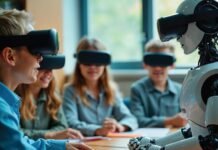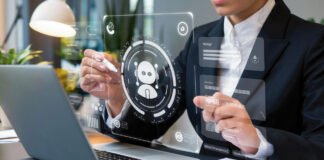HR in 2025 is experiencing a revolution. What was previously very much an administrative role is now a strategic force—powered by Artificial Intelligence. From smart hiring to customized learning journeys, AI in HR isn’t just making things faster but fundamentally changing the way organizations attract and retain people. But as massive as the potential is, so are the complexities. For the C-suite, the issue isn’t so much embracing AI as it’s learning how to leverage it strategically and ethically.
Table of Contents
1. The New Rules of HR Strategy
2. Efficiency Meets Ethical Complexity
3. Personalization at a Cost
4. From Roles to Skills
5. Leadership in the Loop
Trust Will Define the Winners
1. The New Rules of HR Strategy
The old HR playbook centered on roles, compliance, and consistency. But those are no longer sufficient in today’s uncertain business environment. With AI, organizations can now anticipate workforce requirements, maximize team performance, and customize development in volume. More than 60% of global businesses have already incorporated AI into one or more of their fundamental HR processes, as per the 2025 Gartner survey. The companies that once lived on quarterly reports gain access to real-time performance data, sentiment analysis, and skills projection- it is due to Artificial Intelligence.
This is not a marginal improvement; this is more basic. Artificial Intelligence will redesign HR, including job designing, succession planning, etc. The future of HR is active, forecastful, and individualistic.
2. Efficiency Meets Ethical Complexity
Hiring is probably one of the most apparent uses of AI in HR. Algorithms can browse through thousands of resumes and quickly analyze the prospective cultural fit through natural language processing and even predict success rates among the candidates. These efficiencies, however, carry with them hard questions. Does an algorithm exist that is unbiased? What happens when presented with a chosen profile, several times in a row, the AI system guesses that this profile is chosen due to a lack of awareness?
A global tech firm subsequently deactivated its AI-backed hiring algorithm in 2024, which generated an inordinately lower number of recommendations for underrepresented groups. This is not a bug–it is a government issue. The future demands a combination of machine intelligence and human discretion. AI can recommend, but humans need to make the decisions. Clear models, diverse training sets, and continuous bias audits are essential to ensuring automation isn’t used to supersede inclusion.
3. Personalization at a Cost
The second significant change is in the form of talent development fueled by AI. Firms are replacing standardized training programs with adaptive learning paths, customized to the behavior, objectives, and role of every employee. Learning systems now auto-configure content, suggest upskilling modules as a function of performance gaps, and even gamify tracking progress.
But more personalization raises issues of worker privacy. How far should companies track workers’ behavior for the sake of learning optimization? Do workers know what’s being done with their information—and can they opt out?
Finding the right balance between enablement and intrusion is essential. Progressive companies are putting in place explicit consent mechanisms, open data practices, and strong security measures. In the battle to revolutionize talent development with AI, trust must not be an afterthought.
4. From Roles to Skills
Those days are gone when there were fixed job roles and career trajectories. AI is hastening the movement toward a model of a skills-based workforce. Instead of inquiring “What does this individual do?” leaders are inquiring “What are this individual’s skills, and how can we use them in a dynamic way?
This new approach enables agile teams, internal mobility, and project-based resourcing. Organizations such as Unilever have already begun to adopt AI-driven internal talent marketplaces, bringing people to opportunities in real-time based on their actual skills. The outcome? Increased speed of innovation, reduced turnover, and higher employee satisfaction.
By 2027, we anticipate skill taxonomies to become an integral layer in the HR technology stacks of enterprises. With the ongoing development of Artificial Intelligence in talent development, organizations will have to spend not only on tools but completely new workforce approaches.
5. Leadership in the Loop
As artificial intelligence increasingly takes over tasks and decisions, leadership will be confronted with a philosophical challenge: What does it mean to lead when computers provide recommendations ahead of managers? There are now tools that interpret team communication, forecast burnout, and even provide coaching to managers about how to boost team morale. This presents a chance for AI-fluent leadership—executives who can balance data insights, emotional intelligence, and strategic vision.
In order to future-proof HR, the C-suite has to make three investments: AI capability-building for the HR function, ethical governance frameworks, and clear alignment of AI use cases to business results. AI should never be a black box—it should always be an open partner in making decisions.
Trust Will Define the Winners
The final KPI in an AI environment of HR is trust. Employees must feel that their data is secure, that algorithms are not biased, and that executives will own responsibilities. Firms must instill ethical aspects into every action related to the adoption of AI, including its design and up to its deployment.
Forming AI ethics boards, conducting periodical audits, and providing open communication no longer remain discretionary. They are needed in order to maintain credibility over the long run, especially in industries that have high reputational risk.
It is not in the future that HR and talent development will be transformed and reimagined with the use of AI; it is happening now. The question these days to C-suite executives and HR planners is no longer whether AI fits, but whether your organization is primed to advance the next generation of change.
Since individuals will capture the future of work because of the fact that people who embrace the human aspect of AI will do so.
Explore Hrtech Articles for the latest Tech Trends in Human Resources Technology












